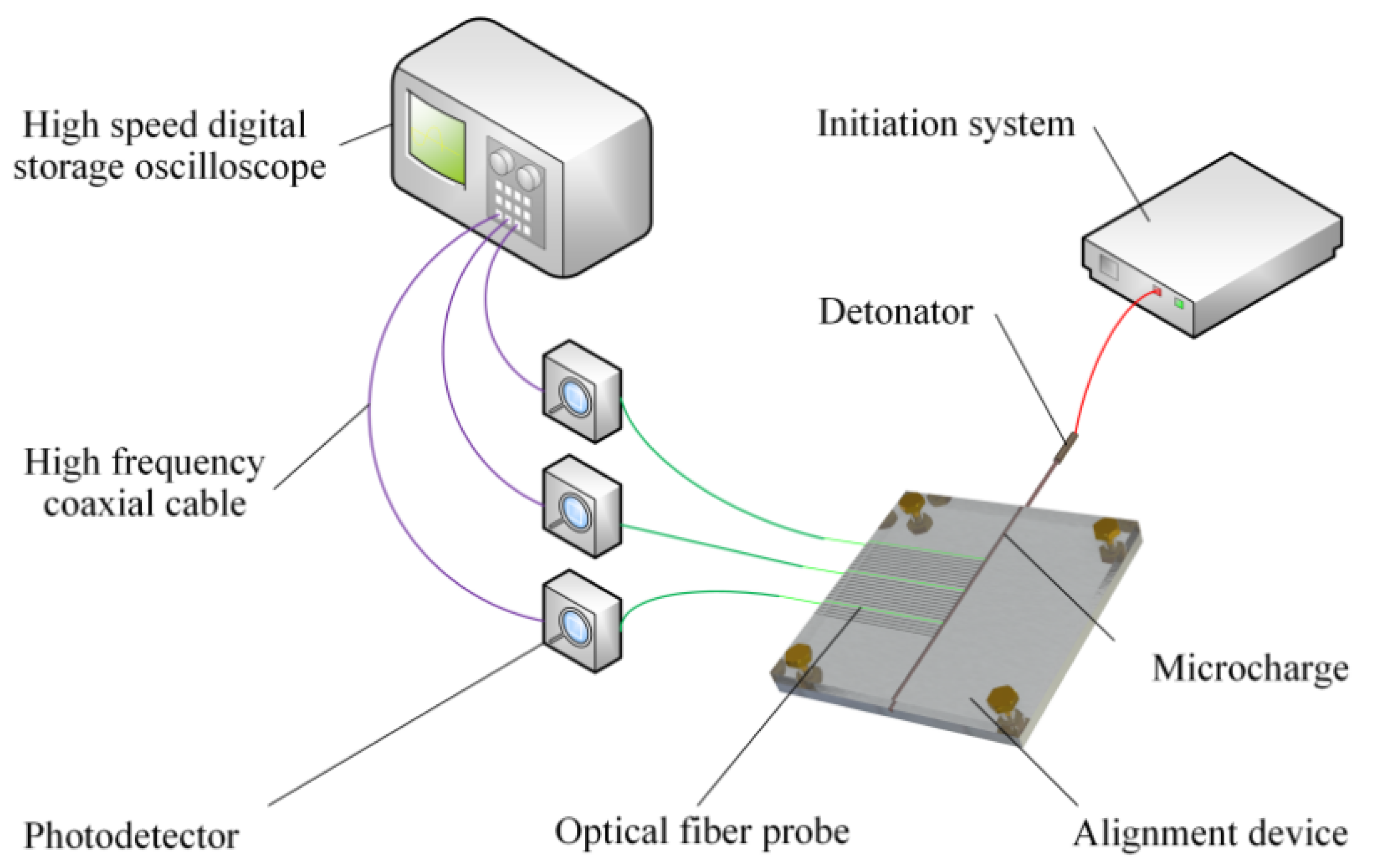4.1. Experimental Results of Different Probe Spacings
Usually, the microcharge length is a few centimeters due to the limitation of manufacturing technology. In order to realize the multi-point measurement of detonation velocity in a finite length, it is necessary to study the optimal distance between fiber probes. For discussing the influence of probe spacing on detonation velocity, four groups of experiments were carried out and each group of experiments was repeated three times. In the four groups of experiments, fiber probe spacings were set to 1, 2, 3 and 4 mm, respectively. The typical signals collected by the oscilloscope are shown in
Figure 10, which corresponds to the first experiment with conditions of
L = 4 mm and
a = 0.5 mm.
The time when the detonation wave reaches the corresponding position was all read at the output voltage of 0.15 mV for reducing the influence of noise signals on reading. The experimental data and the corresponding detonation velocity
D and correlation coefficient
γ calculated by Equations (3) and (4) are shown in
Table 5,
Table 6,
Table 7 and
Table 8. It can be observed that every calculated detonation velocity
D is meaningful because its correlation coefficient is 1.000 in the case of four significant digits.
The average detonation velocity
and corresponding standard deviation
σD of each group of experiments are given in
Table 9 by Equations (5) and (6).
4.2. Results of Comparative Experiment
In order to verify the feasibility and accuracy of the method applied in this paper, the comparative experiments between ionization probes and fiber probes were performed. In our previous research [
15], a flexible ionization-conducted probe sensor was used for measuring detonation velocity produced by a booster explosive which is the same as that employed in this paper. In addition, the initiation mode, charge size, and constraint condition of the explosive are also consistent with this contribution. The experiments were performed under the condition that the spacing between two adjacent ionization probe groups (called
d) is 1 mm, 2 mm, 4 mm, and 8 mm, respectively. The average detonation velocity and corresponding standard deviation of each group of experiments are given in
Table 10.
4.3. Discussions
Table 9 shows that the detonation velocity of each group of experiments is basically consistent. However, the standard deviation of
L = 4 mm is significantly smaller than the others, which may be attributed to the NA of the optical fiber.
As we know, the NA represents the angle range of incident light received by the optical fiber, that is to say, the light in a certain angle range will pass through the fiber and be converted into an electrical signal by the photodetector. Considering the complexity of the detonation process, when the detonation wave propagates to a certain position where is in the light receiving range of the fiber, the oscilloscope may be triggered and generate a step signal. As shown in
Figure 3, the uncertainty range of optical signals can be defined as
h. Under other invariable conditions, the smaller the value of
h/
L, the lower the standard deviation of detonation velocity. In this study, the
h value of each experiment is the same and the
L value of the fourth group of experiments is the largest. Therefore, the minimum standard deviation of
L = 4 mm is understandable. Furthermore, based on these experimental results, the value of
h/
L should preferably be less than 0.1.
The theoretical detonation velocity can be calculated by employing Explo5 thermo-chemical prediction software and it is approximately 8743 m/s [
15]. According to our previous research,
d = 4 mm is an appropriate choice for the densely arranged ionization probe array. Under this condition, the average detonation velocity of the booster explosive is 8656 m/s and the standard deviation is 57 m/s. Our measurement results are all close to the theoretical value. However, compared with the case of
L = 4 mm in this paper, the detonation velocity and standard deviation acquired by the ionization probe are small and large, respectively. This occurrence may be due to the difference in measurement mechanism between the two methods.
The ionization probe group at the off-state can respond to an incoming detonation wave with the conduction induced by ionization characteristics of the detonation reaction zone. The reaction zone width can be considered as the uncertainty range of electrical signals and it is less than the value of
h in this paper [
16,
17]. The time interval between two probes may become smaller or larger than the ideal conditions because of the existence of uncertainty range. Therefore, the detonation velocity measured by fiber probes may be higher than that by electric probes. However, due to the influence of electromagnetic interference, the standard deviation of detonation velocity measured by ionization probes will be larger than that by fiber probes.
In this study, the total error mainly includes the fiber probe spacing error caused by the base plate fabrication, fiber probe installation, the timing error of the oscilloscope and photodetector, and the reading error. The error of the fiber probe spacing caused by the base plate fabrication can be declined by employing femtosecond laser processing technology. Moreover, the reading error can be improved by employing a time-interval measuring instrument with high sampling clock frequency and measuring the principle of the time to voltage converter method.















